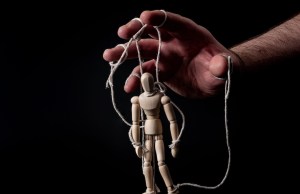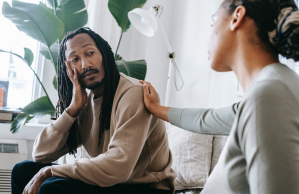Healthy relationships have the power to bring joy, connection, and improved self-esteem. However, anxiety can disrupt those feelings and take a toll, both on the person experiencing it and their partner.
By understanding the roots of anxiety and its impact on the relationship, couples can create emotional safety and develop strategies to support one another effectively. Read on to learn more about how anxiety manifests in relationships, the challenges it can create, and actionable steps couples can take to manage it together.

How Does Anxiety Affect Relationships? The Impact of Anxiety on Relationships
Anxiety can make building and maintaining relationships more challenging than it would be otherwise. Left unmanaged, anxiety and anxiety disorders can lead to overthinking, reading into situations, low self-esteem, and more. These issues can undermine trust in relationships and create unnecessary conflict.
However, when properly managed and supported by a caring partner, anxiety symptoms can be worked through, allowing the relationship to flourish and both parties to feel seen, understood, and cared for.
If I Have Anxiety, How Will It Show Up in My Relationship?
Anxiety often interferes with being present and enjoying the moment, which can impact relationships of all kinds—not just romantic ones. Here are some common ways anxiety may show up in romantic relationships:
- Excessive worry or doubt. Anxiety may cause frequent questioning about the relationship, your partner’s actions, or the relationship’s future. While some doubt is normal, especially during challenging times, constant or all-consuming worry may be a sign of anxiety at work.
- Constant need for validation. The worry anxiety causes may lead to seeking frequent reassurance from a partner about their feelings, loyalty, or commitment. These consistent questions and concerns can sometimes strain the relationship without effective management strategies.
- Stonewalling. In an attempt to avoid difficult emotions, anxiety may lead to stonewalling—shutting down emotionally and avoiding communication. This behavior can cause trouble in relationships, as it cuts off your access to support, keeps your partner at a distance emotionally, and stalls healthy communication about the issue.
- Self-sabotage. Anxiety can cause—and result from—negative core beliefs, such as feeling unlovable or undeserving of love. These beliefs may cause someone to consciously or unconsciously look for signs that the relationship will fail, often creating a self-fulling prophecy.
- Sleep disturbances. Staying up late and ruminating on how the relationship is or isn’t going in the right direction, can be a sign of anxiety.
- Self-silencing (self-censoring). Anxiety’s tendency toward avoidant behavior often makes it difficult to voice when something about a relationship is bothering you. Though keeping your thoughts and feelings in may provide some temporary relief, the problem will remain until it’s addressed.
What Is Separation Anxiety Like in Relationships?
Separation anxiety is when a person becomes excessively anxious or worried when separated from a loved one. While more common in children (when separated from a parent or caregiver), it can also affect adults. Symptoms may include ruminating about the partner’s well-being, catastrophizing about worst-case scenarios, or struggling to function independently. In severe cases, it may prevent someone from interacting with others, functioning effectively in daily life, and completing work or school tasks.
Separation anxiety can lead to an imbalance in a relationship if one partner becomes overly dependent upon the other. The anxious partner’s needs may take center stage, leaving their partner’s needs consistently unmet.
What Causes Anxiety in Relationships?
People experience anxiety for a wide variety of reasons, many of them rooted in their personal histories.
- Anxiety disorders: If left unmanaged, anxiety disorders like generalized anxiety disorder (GAD) can make it difficult to have trust and to talk openly about relationship challenges.
- Personal history: Past experiences of betrayal, mistreatment, or neglect can create lingering fears and anxiety that make managing close relationships more difficult. Factors like low self-esteem and complex trauma can be exacerbated by the closeness and trust a relationship necessitates and lead to insecurity, stress, and tension.
- Insecure attachment styles: Experiences from childhood can be especially impactful, as they inform a person’s ability to form attachments. As children become adults, they develop certain attachment styles, not all of which contribute positively to their long-term health and well-being. Specifically, avoidant insecure and ambivalent insecure attachment styles are associated with lower marital satisfaction.
How Do I Stop Being Anxious in My Relationship?
Feeling anxiety about your relationship is often an experience that’s unique to each person, with different causes at its root. One of the most effective ways to treat anxiety is to find out what that root is, which can be done in many ways. One way to start this process is to start incorporating mindfulness into your daily life by taking notice of what events or behaviors trigger anxiety spikes.
However, tracing anxiety back to its source can be difficult to do all on your own, so seeing a mental health professional can also be extremely helpful. They can help talk you through the finer points of how to assess your thoughts and behaviors, make connections to past events, and give you tools personalized to manage your anxiety.
When you’re feeling anxious, there are many coping strategies you can use to reduce anxiety in the moment. Examples include:
- Breathing exercises: Exercises like box breathing can help steady your heart rate and calm your nervous system, reducing feelings of anxiety.
- Grounding exercises: Exercises like the 54321 technique or the 333 technique can help stop anxiety in the moment and keep it from getting out of control. They help ground you in the present and keep you out of any thought spirals you may be experiencing.
- Awareness of triggers: As stated above, try to notice what triggers your anxiety. These might be things your partner says or does, situations that you or your partner are in, etc. You can bring a list of triggers to therapy to talk through with your provider, and they can help you figure out what’s causing them.
In the long-term, seeing a mental health professional, either in individual counseling, couples counseling, or both, is the most effective way to reduce anxiety related to relationships and ensure that your relationship can be healthy, happy, and strong.
Strategies for Supporting Your Partner with Anxiety
As previously mentioned, anxiety is challenging to work through, even with the help of a partner. Here are some strategies to help them:
- Set them up for success: Work proactively by encouraging them to get enough sleep, eat at regular intervals, pay attention to what food they consume and how it makes them feel, drink enough water, watch what media they consume, and exercise. This may also include talking about medication options and whether they would be appropriate or helpful.
- Talk about triggers: This means identifying what makes your partner anxious (i.e. their anxiety triggers) as well as asking for input on when to challenge them to help them learn how to work through their anxieties. It’s important to challenge anxious thoughts, but their energy level and emotional state in anxious moments should also be considered, so conversations around this are important to have.
- Identify clues that the partner is experiencing anxiety: Identifying when the anxiety is beginning to build can help stop it from turning into a full-blown anxiety attack, as that’s the time to slow down and use coping skills. This is an important skill for anxiety-prone people to learn on their own, but intervention from a partner can also be helpful.
- Come up with a plan to help them calm down: This includes things to say, activities that make them feel calm (deep breathing, fidgets, rubbing a worry stone, helping them break the situations down, listening to music, telling them that they’re okay and encouraging them to repeat it to themselves), knowing when to leave a situation, and keeping track of where quiet space(s) are in public. It may also help to come up with a code word to indicate when to put the plan into action. Be sure to practice it a few times so you both (and potentially close friends) know what to do when the anxiety is flaring up.
- Do not take the anxiety personally: When a person’s anxiety escalates, they tend to say things they don’t mean or wouldn’t say when they’re calm. If there’s something that sticks with you, consider talking to them about it in a non-judgmental way, maybe using “I” statements. By bringing up your hurt feelings without placing blame on them, you can both clear the air and repair trust, increasing your emotional intimacy and closeness.
- Take care of yourself: If you feel overwhelmed or emotionally exhausted, you are not going to be able to care for others as much as you would like. It is completely normal to need time to yourself to recharge, especially when you’re helping your partner manage their anxiety. In and out of relationships, self-care is an important facet of overall well-being.
If coping strategies alone are not feeling like enough, consider attending individual and/or couples therapy. A mental health professional can help you find balance in your relationship by working with you to establish ways to meet both of your needs without sacrificing the other person’s.













